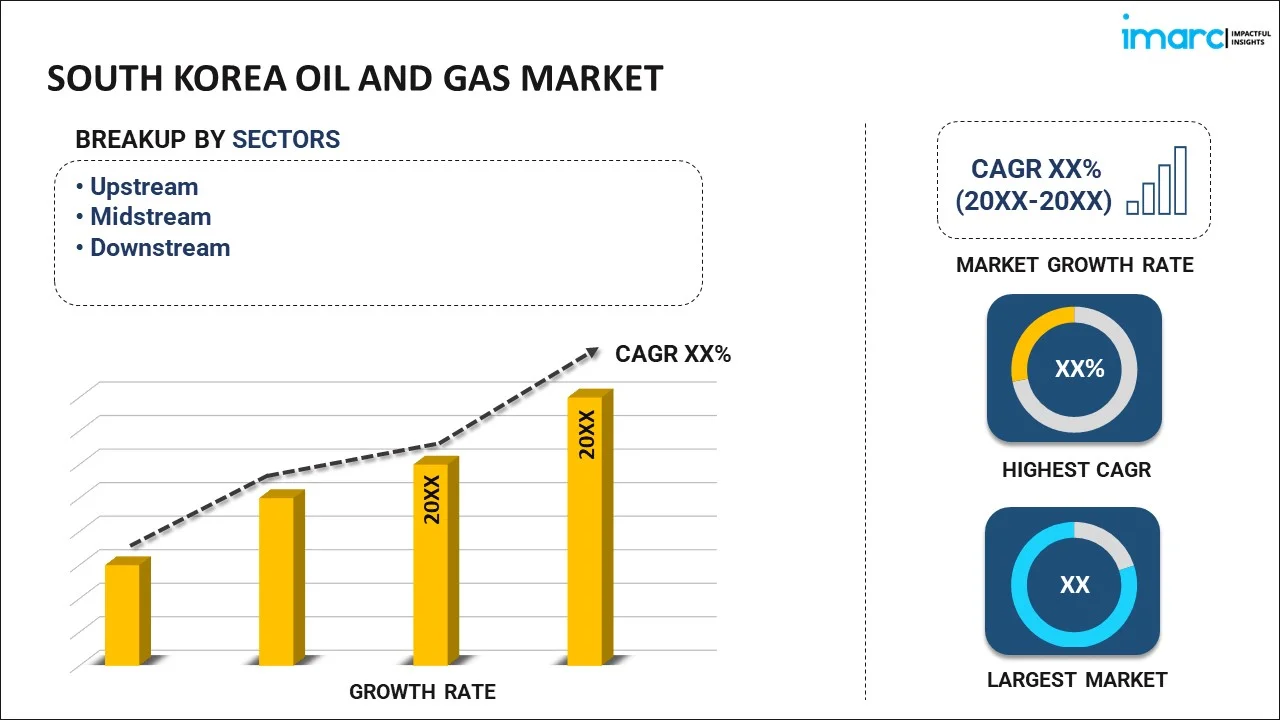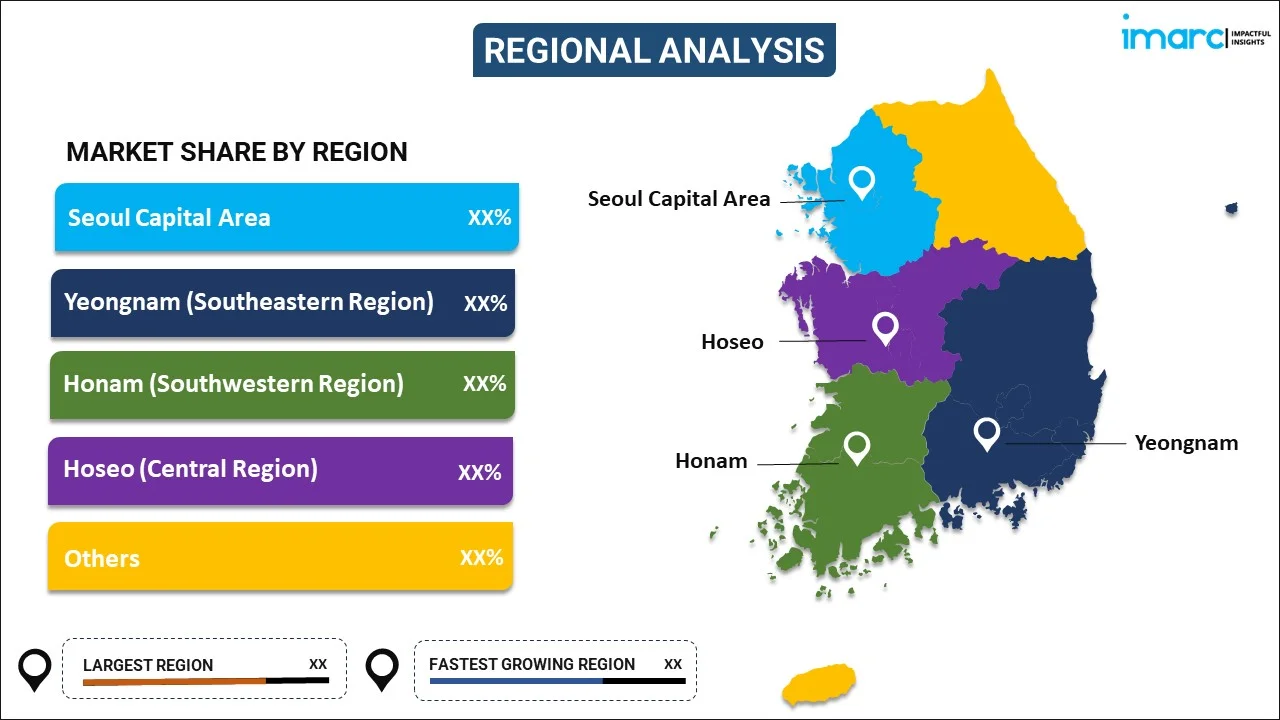
South Korea Oil and Gas Market Report by Sector (Upstream, Midstream, Downstream), and Region 2025-2033
Market Overview:
South Korea oil and gas market size reached USD 390.0 Million in 2024. Looking forward, IMARC Group expects the market to reach USD 1,340.0 Million by 2033, exhibiting a growth rate (CAGR) of 13.30% during 2025-2033. The growing need for energy in the industrial sector to operate heavy machinery, increasing demand for a reliable supply of crude oil and natural gas, and rising improvements in oil and gas exploration represent some of the key factors driving the market.
|
Report Attribute
|
Key Statistics
|
|---|---|
|
Base Year
|
2024
|
|
Forecast Years
|
2025-2033
|
|
Historical Years
|
2019-2024
|
|
Market Size in 2024
|
USD 390.0 Million |
|
Market Forecast in 2033
|
USD 1,340.0 Million |
| Market Growth Rate 2025-2033 | 13.30% |
Oil and gas are naturally occurring fossil fuels found beneath the surface of the Earth, consisting of a combination of organic materials and geological processes that have resulted in their accumulation. They comprise crude oil, which is employed to manufacture gasoline, diesel, jet fuel, and other petrochemical products and natural gases like ethane, propane, and butane. They also encompass unconventional resources that require non-traditional extraction methods, including shale gas and oil sands. They are extracted by drilling a hole into the Earth, reaching the reservoir wherein oil and gas are trapped, and using various techniques to bring the hydrocarbons to the surface. They often undergo innumerable refining processes to remove impurities and other harmful elements for making them safe to use. They are exported from production sites to refineries or processing facilities with the help of pipelines, tankers, and liquefied natural gas (LNG) terminals. They rely on various services, such as consulting, equipment manufacturing, and technology development that support the operations. They ensure a stable and reliable supply of energy to meet the growing needs of the industrial, residential, and commercial sectors. Oil and gas are crucial raw materials in various manufacturing processes, such as the production of synthetic fibers and lubricants.
South Korea Oil and Gas Market Trends:
At present, the increasing energy demand in the industrial sector to operate heavy machinery and maintain productivity and efficiency represents one of the crucial factors impelling the growth of the market in South Korea. The rising shift towards renewable energy sources and increased investment in energy efficiency technologies is also strengthening the market growth. Besides this, the growing transition towards cleaner and environment-friendly fossil fuels like natural gas, driven by rising environmental concerns and the need to mitigate climate change, is offering a favorable market outlook in the country. In addition, the escalating demand for a reliable supply of crude oil and natural gas feedstock for the operations of the petrochemical industry is contributing to the market growth. This is also leading to strategic partnerships and long-term contracts with major oil-producing companies, securing a stable supply chain and reducing the impact of price volatility. Apart from this, the increasing adoption of advanced technologies, such as artificial intelligence (AI), data analytics, and the internet of things (IoT), to optimize operations, enhance safety, and reduce costs is supporting the market growth in the country. Additionally, investments in research and development (R&D) to improve oil and gas exploration and production capabilities, seeking to increase its energy self-sufficiency, are bolstering the market growth.
South Korea Oil and Gas Market Segmentation:
IMARC Group provides an analysis of the key trends in each segment of the market, along with forecasts at the country level for 2025-2033. Our report has categorized the market based on sector.
Sector Insights:

- Upstream
- Midstream
- Downstream
The report has provided a detailed breakup and analysis of the market based on the sector. This includes upstream, midstream, and downstream.
Regional Insights:

- Seoul Capital Area
- Yeongnam (Southeastern Region)
- Honam (Southwestern Region)
- Hoseo (Central Region)
- Others
The report has also provided a comprehensive analysis of all the major regional markets, which include Seoul Capital Area, Yeongnam (Southeastern Region), Honam (Southwestern Region), Hoseo (Central Region), and Others.
Competitive Landscape:
The market research report has also provided a comprehensive analysis of the competitive landscape in the market. Competitive analysis such as market structure, key player positioning, top winning strategies, competitive dashboard, and company evaluation quadrant has been covered in the report. Also, detailed profiles of all major companies have been provided.
South Korea Oil and Gas Market Report Coverage:
| Report Features | Details |
|---|---|
| Base Year of the Analysis | 2024 |
| Historical Period | 2019-2024 |
| Forecast Period | 2025-2033 |
| Units | Million USD |
| Scope of the Report | Exploration of Historical and Forecast Trends, Industry Catalysts and Challenges, Segment-Wise Historical and Predictive Market Assessment:
|
| Sectors Covered | Upstream, Midstream, Downstream |
| Regions Covered | Seoul Capital Area, Yeongnam (Southeastern Region), Honam (Southwestern Region), Hoseo (Central Region), Others |
| Customization Scope | 10% Free Customization |
| Post-Sale Analyst Support | 10-12 Weeks |
| Delivery Format | PDF and Excel through Email (We can also provide the editable version of the report in PPT/Word format on special request) |
Key Questions Answered in This Report:
- How has the South Korea oil and gas market performed so far and how will it perform in the coming years?
- What has been the impact of COVID-19 on the South Korea oil and gas market?
- What is the breakup of the South Korea oil and gas market on the basis of sector?
- What are the various stages in the value chain of the South Korea oil and gas market?
- What are the key driving factors and challenges in the South Korea oil and gas?
- What is the structure of the South Korea oil and gas market and who are the key players?
- What is the degree of competition in the South Korea oil and gas market?
Key Benefits for Stakeholders:
- IMARC’s industry report offers a comprehensive quantitative analysis of various market segments, historical and current market trends, market forecasts, and dynamics of the South Korea oil and gas market from 2019-2033.
- The research report provides the latest information on the market drivers, challenges, and opportunities in the South Korea oil and gas market.
- Porter's five forces analysis assist stakeholders in assessing the impact of new entrants, competitive rivalry, supplier power, buyer power, and the threat of substitution. It helps stakeholders to analyze the level of competition within the South Korea oil and gas industry and its attractiveness.
- Competitive landscape allows stakeholders to understand their competitive environment and provides an insight into the current positions of key players in the market.
Need more help?
- Speak to our experienced analysts for insights on the current market scenarios.
- Include additional segments and countries to customize the report as per your requirement.
- Gain an unparalleled competitive advantage in your domain by understanding how to utilize the report and positively impacting your operations and revenue.
- For further assistance, please connect with our analysts.
 Inquire Before Buying
Inquire Before Buying
 Speak to an Analyst
Speak to an Analyst
 Request Brochure
Request Brochure
 Request Customization
Request Customization




.webp)




.webp)












